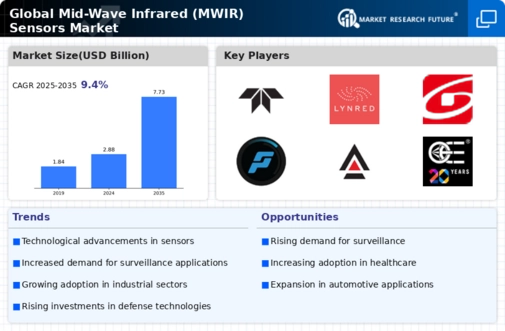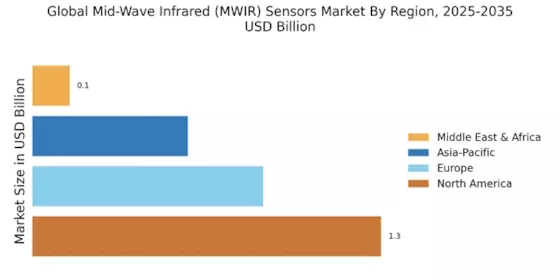Growth in Automotive Sector
The automotive industry's shift towards advanced driver-assistance systems (ADAS) is contributing to the growth of the Mid-Wave Infrared (MWIR) Sensors Market. As vehicles increasingly incorporate thermal imaging for pedestrian detection, collision avoidance, and night vision, the demand for MWIR sensors is expected to rise. The automotive sector is projected to witness a compound annual growth rate of around 10% in the coming years, with MWIR sensors playing a crucial role in enhancing vehicle safety and performance. This trend indicates a promising future for MWIR technology within the automotive landscape.
Enhanced Security and Surveillance Needs
The escalating demand for advanced security and surveillance systems is likely to propel the Mid-Wave Infrared (MWIR) Sensors Market. With the rise in security threats and the need for effective monitoring solutions, MWIR sensors are being integrated into various security applications, including perimeter security and critical infrastructure protection. The market for security and surveillance is projected to grow significantly, with MWIR sensors providing superior imaging capabilities in low-light conditions. This trend suggests that the adoption of MWIR technology could become a standard in security systems, further driving market expansion.
Growing Demand for Non-Destructive Testing
The rising need for non-destructive testing (NDT) methods across various industries is emerging as a significant driver for the Mid-Wave Infrared (MWIR) Sensors Market. MWIR sensors are increasingly utilized in NDT applications for detecting material defects, thermal anomalies, and structural integrity assessments. Industries such as aerospace, automotive, and construction are adopting these technologies to ensure safety and compliance with regulatory standards. The NDT market is anticipated to expand, with MWIR sensors playing a pivotal role in enhancing inspection processes and reducing operational risks.
Rising Adoption in Industrial Applications
The increasing utilization of Mid-Wave Infrared (MWIR) sensors in various industrial applications appears to be a key driver for the MWIR Sensors Market. Industries such as manufacturing, oil and gas, and chemical processing are increasingly employing these sensors for temperature measurement, gas detection, and process monitoring. The ability of MWIR sensors to operate effectively in harsh environments enhances their appeal, potentially leading to a market growth rate of approximately 8% annually. This trend indicates a growing recognition of the benefits offered by MWIR technology in improving operational efficiency and safety standards.
Increasing Focus on Research and Development
The emphasis on research and development in the field of infrared technology is fostering innovation within the Mid-Wave Infrared (MWIR) Sensors Market. Various research institutions and companies are investing in the development of next-generation MWIR sensors that offer improved sensitivity, resolution, and miniaturization. This focus on R&D is likely to lead to the introduction of advanced products that cater to diverse applications, including medical imaging and environmental monitoring. The potential for breakthroughs in sensor technology may significantly influence market dynamics and drive growth.
















